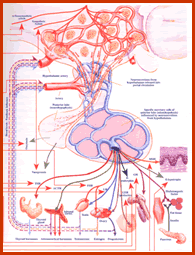


on the importance of regular practice of
the Transcendental Meditation technique:
of SELF-REFERRAL DIRECTION involved in structuring Rk Veda.
With reference to consciousness, Nirukt comprises the specific sets of laws of
Nature that are engaged in promoting the quality of Chhandas--the object of
direct way for the fulfillment of the supreme philosophy of
life, where the individual gains what he wants, where the
individual lives life in enlightenment, and where the
individual breathes life in cosmic reality.
-Introduction to Maharishi Vedic University, p. 262

©2001 Maharishi Vedic Library
•contact us•
of Rishi--within the Samhita level of consciousness, providing a structure to the
eternally silent, self-referral, self-sufficient, fully awake state of
consciousness, which is intimately personal to everyone.
(complete table of qualities)
the pituitary gland, the neurohypophysis,
and the sympathetic and parasympathetic
systems. These are activated by the limbic
system and the hypothalamic releasing
factors.
They expand the response and bring it back
towards the organs and organ systems of the
physiology through a feedback loop that
maintains homeostatic balance.
-His Majesty Prof. Tony Nader-Ram in
Human Physiology: Expression of
Veda and the Vedic Literature, pp. 91-93

more about Nirukt
-a list of words
-a commentary on the meaning of words in the Nighantu
end of page
![]()
